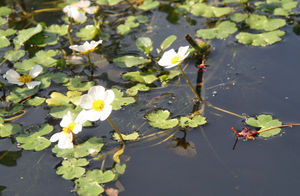Difference between revisions of "Common water-crowfoot"
From eagle-rock.org
| Line 1: | Line 1: | ||
: ''Also called: white water-crowfoot'' | : ''Also called: white water-crowfoot'' | ||
| + | This plant grows well in our pond. I found this plant in nature. The flowers are 7 to 20 mm. This plant adds oxygen to the water, an advantage when you have fish in your pond. Both the leaves under and on the water can be eaten fresh or dried. (JE) | ||
{{taxobox | {{taxobox | ||
| Line 16: | Line 17: | ||
|binomial = ''Ranunculus aquatilis'' | |binomial = ''Ranunculus aquatilis'' | ||
|}} | |}} | ||
| − | |||
| − | |||
| − | |||
== Habitat == | == Habitat == | ||
Revision as of 18:32, 21 May 2012
- Also called: white water-crowfoot
This plant grows well in our pond. I found this plant in nature. The flowers are 7 to 20 mm. This plant adds oxygen to the water, an advantage when you have fish in your pond. Both the leaves under and on the water can be eaten fresh or dried. (JE)
| Ranunculus aquatilis | |
|---|---|

| |
| Ranunculus aquatilis | |
| Scientific classification | |
| Kingdom: | Plantae |
| Order: | Ranunculales |
| Family: | Ranunculaceae |
| Subfamily: | Faboideae |
| Tribe: | Robinieae |
| Genus: | Ranunculus |
| Species: | R. aquatilis |
| Binomial name | |
| Ranunculus aquatilis | |
Habitat
Ponds, ditches, canals, streams, ponds, clay pits and dune ponds, sometimes in periodically flooded areas (annual in that case).
Gallery
See also
External links
- Ranunculus aquatilis Wikipedia
